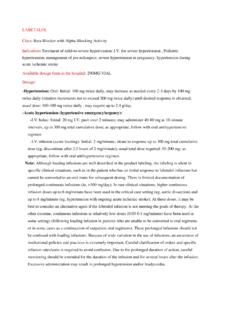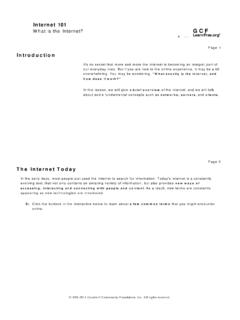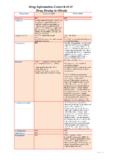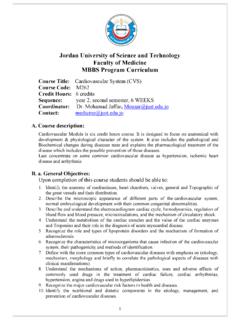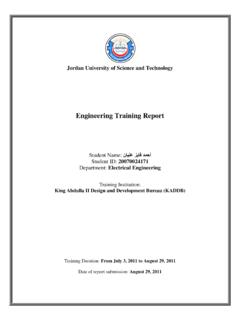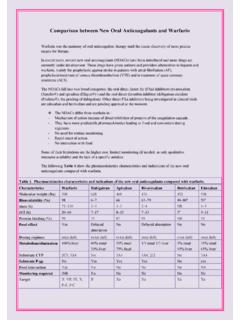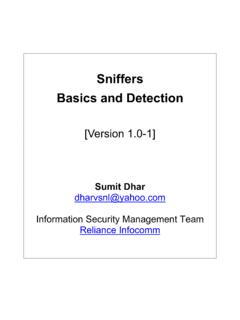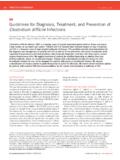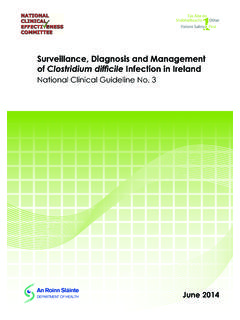Transcription of ESCMID guideline: diagnosis and treatment of acute ...
1 ORIGINAL ARTICLEESCMID guideline: diagnosis and treatment of acute bacterial meningitisD. van de Beek1, C. Cabellos2, O. Dzupova3, S. Esposito4, M. Klein5, A. T. Kloek1, S. L. Leib6, B. Mourvillier7, C. Ostergaard8,P. Pagliano9, , R. C. Read10, O. Resat Sipahi11and M. C. Brouwer1, for the ESCMID Study Group for Infections of theBrain (ESGIB)1)Department of Neurology, Academic Medical Center, Amsterdam, The Netherlands,2)Department of Infectious Diseases, Hospital Universitari de Bellvitge,Barcelona, Spain,3)Department of Infectious Diseases, Charles University, Third Faculty of Medicine, Prague, Czech Republic,4)Pediatric Highly Intensive CareUnit, Fondazione IRCCS Ca Granda Ospedale Maggiore Policlinico, Universit degli Studi di Milano, Milan, Italy,5)Department of Neurology, KlinikumGro hadern, Munich, Germany,6)Institute for Infectious Diseases, University of Bern, Bern, Switzerland,7)Department of Intensive Care Medicine, GroupeHospitalier Bichat-Claude Bernard, Paris, France,8)Department of Clinical Microbiology, Copenhagen University Hospital Hvidovre, Hvidovre,Denmark,9)Department of Infectious Diseases, D.
2 Cotugno Hospital, Naples, Italy,10)Department of Infectious Diseases, Southampton General Hospital,Southampton, United Kingdom and11)Department of Infectious Diseases and Clinical Microbiology, Ege University, Izmir, TurkeyKeywords:Antibiotic, bacterial meningitis, ESCMID , guideline,Neisseria meningitidis,Streptococcus pneumoniaeOriginal Submission:10 December 2015;Accepted:11 January 2016 Editor: D. RaoultArticle published online:7 April 2016 Corresponding Brouwer, Department of Neurology,Academic Medical Center, Meibergdreef 9, 1105 AZ Amsterdam, introductionMotivation for guideline developmentBacterial meningitis is a severe infectious disease of the mem-branes lining the brain resulting in a high mortality and morbiditythroughout the world. In the past decades the epidemiology andtreatment strategies for community-acquired bacterial meningitishave significantly changed[1 3]. First, the introduction of con-jugate vaccines in Europe resulted in the virtual disappearance ofHaemophilus influenzaetype b, while conjugate pneumococcal andmeningococcal vaccines have substantially reduced the burden ofbacterial meningitis[1].
3 As a result, community-acquired bacterialmeningitis has become a disease that currently affects more adultsthan infants, with its specific complications and treatment secondimportant development isthe increasing rate of reducedsusceptibility to common antimicrobial agents among strains ofStreptococcus pneumoniae(pneumococcus) andNeisseria meningi-tidis(meningococcus). Large differences in resistance rates inEurope exist, and empiric antibiotic treatment needs to beadjusted according to regional epidemiology. Finally, severaladjunctive treatments have been tested in randomized controlledtrials, often with conflicting results[3]. These developments leavethe physician in need of a clear practical guideline, summarizingthe available evidence for diagnostic methods, and antimicrobialand adjunctive treatment in bacterial meningitis. To this end theEuropean Society for Clinical Microbiology and Infectious Dis-eases ( ESCMID ) promotes guidelines development in thefield ofinfectious diseases.
4 This guideline project was initiated by theESCMID Study Group for Infections of the Brain (ESGIB).Aim of guidelineThe guideline is aimed at providing guidance in daily practice fordiagnosis and treatment of community-acquired bacterialmeningitis in hospitals. The conclusions of the guideline provideup-to-date scientific evidence for best medical practice. Therecommendations are aimed at explicating this best medicalpractice and are based on available scientific evidence and theconsiderations of the guideline committee formulated ten key questions and severalsubquestions, which aim to address the full spectrum of currentclinical dilemmas in the diagnosis and treatment of community-acquired bacterial What are the causative microorganisms of community-acquired bacterial meningitis in specific groups (neonates,children, adults and immunocompromised patients)? What are the clinical characteristics of community-acquiredbacterial meningitis, and what is their diagnostic accuracy?
5 Clin Microbiol Infect2016;22:S37 S62 2016 European Society of Clinical Microbiology and Infectious Diseases. Published by Elsevier Ltd. All rights What is the diagnostic accuracy of algorithms in thedistinction between bacterial and viral meningitis?4. Can we use clinical characteristics to predict the absenceof intracranial abnormalities associated with increased riskof lumbar puncture? If lumbar puncture is delayed, should we start treatment ? What is the optimal type, duration and method ofadministration of antibiotic treatment when startedempirically, after the pathogen has been identified or inculture-negative patients? Does the addition of vancomycin or rifampicin to a third-generation cephalosporin improve outcome inpneumococcal meningitis patients in the setting of a highresistance rate of pneumococci?6. Does dexamethasone have a beneficial effect on death,functional outcome and hearing loss in adults andchildren with bacterial meningitis?
6 Up to what point in time is treatment with dexamethasoneindicated if antibiotics are already provided? Should dexamethasone be stopped if pathogens otherthanS. pneumoniaeare identified?7. Do glycerol, mannitol, acetaminophen/paracetamol,hypothermia, antiepileptic drugs or hypertonic salinehave a beneficial effect on death, functional outcomeand hearing loss in adults and children with bacterialmeningitis?8. Does the use of prophylactic treatment of householdcontacts decrease carriage or secondary cases? Is vaccination indicated after community-acquired(pneumococcal) meningitis?9. What complications occur during community-acquiredbacterial meningitis, what ancillary investigations arewarranted when complications occur and how shouldthey be treated? What follow-up of community-acquired bacterialmeningitis patients should be provided ( testing forhearing loss, neuropsychologic evaluation)?
7 Meningococcal disease but also other bacterial infections canpresent with both meningitis and sepsis. This guideline is notaimed at the urgent recognition and treatment of sepsis pa-tients. Therefore, if meningococcal sepsis is suspected thephysician should refer to other guidelines specific forrecognizing children/patients with developing shock who needacute sepsis management ( NICE guidelines , ).Professional audienceThis guideline is written for all clinicians involved in diagnosis , treatment and follow-up of bacterial meningitis in adults andchildren with community-acquired bacterial meningitis in thecontext of hospital care, including infectious disease specialists,neurologists, intensive care specialists, paediatricians of guideline committeeThe initiation of the guideline project was announced at theESGIB business meetings of 2011 and 2012 during the EuropeanConference on Clinical Microbiology and Infectious Diseases(ECCMID).
8 During this meeting ESGIB members were invitedto join the guideline committee by approaching the guidelinechairman. In composing the guideline, committee consider-ations were given to establish a balance in country of origin,gender and medical specialty of the guideline members. Afterthefirst meeting the guideline committee was reinforced withtwo additional members because their specific expertise wasoriginally underrepresented in the of committee to guideline developmentAfter the guideline preparation project was granted ESCMID funding in Summer 2013, a kickoff meeting was staged inAmsterdam (October 2013) at which the key questions andsubquestions were formulated and divided between guidelinemembers. A clinical librarian and a research fellow at the chair sinstitute were appointed to perform the literature searches foreach question. Guideline committee members received theidentified literature and formulated the answers to the ques-tions, which were discussed during a second meeting heldsimultaneously with the 2014 ECCMID meeting in Barcelona,Spain.
9 During the meeting consensus was reached for mostissues, and unanswered questions were identified and distrib-uted between committee members. The research fellow andchair prepared a draft version of the guideline, which wasdistributedfirst to other guidelines members and subsequentlyto ESGIB members and ESCMID for participationFor the development of a high-quality guideline, patient input isessential, as the treatment has to fulfil the demands and expec-tations of patients and caregivers. To incorporate these factorsinto the guideline, the United Kingdom based MeningitisResearch Foundation was approached to participate in theguideline development and provide comments. 2016 European Society of Clinical Microbiology and Infectious Diseases. Published by Elsevier Ltd. All rights reserved,CMI,22,S37 S62S38 Clinical Microbiology and Infection, Volume 22 Number S3, May 2016 CMIM ethods of guideline developmentLiterature preparation for this guideline developmentproject, a search was performed for existing guidelines fromguideline institutes ( , , )and (inter)national societies for neurologists, paediatricians andinfectious disease specialists.
10 Furthermore, systematic reviewswere searched in the Cochrane Library and SUMsearch. Sub-sequently, for all identified questions a specific search wasperformed in scientific publications using electronic databasesPubMed, Medline and Embase (1966 2014). Additional publi-cations were identified by cross-reference checking of identi-fied literature. In the search hierarchy the initial aim was toidentify systematic meta-analysis or meta-analyses of random-ized controlled trials (RCTs). In the absence of RCTs a furthersearch was performed for prospective controlled studies. Keyquestions were formulated in a PICO format (Population,Intervention, Control, Outcome) when appropriate. Searchstrategies were developed by a clinical librarian at the chair sinstitute (AMC, Amsterdam, Netherlands) for all PICO formatted questions (Appendix).Quality of evidence literature was selected by thecommittee members and was graded for quality on the basis ofthe ESCMID quality-of-evidence system (Table ).
